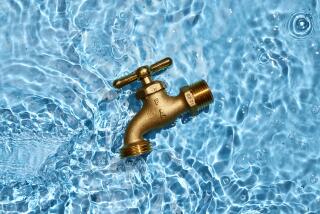EPA Proposes Lead Level Limits in Drinking Water
WASHINGTON — The Environmental Protection Agency, responding to a mandate from Congress to reduce lead in public drinking water, issued new proposed regulations Wednesday aimed at limiting exposure to the toxic metal for more than 138 million Americans.
Under the EPA plan, community water suppliers would for the first time be required to monitor pipe corrosion that can increase the lead content in drinking water and, when excessive levels are found, implement a special treatment program.
The proposal could require treatment programs at an estimated 53,000 public water systems across the country, the EPA said, at a capital cost of $674 million. That could lead to increases in consumer fees from $1 to $27 a year, depending on the size of the water system.
Little Impact on Area
Federal and Los Angeles water officials said they expected relatively little impact on Southern California in comparison to older urban centers in the East. There is very little lead in Los Angeles’ water, little or no lead piping in the local water distribution system and lead solder is banned in new housing plumbing, they said.
However, federal officials have estimated that as many as 42 million Americans nationwide may be exposed to potentially dangerous levels of lead. Consumed even in small amounts, the metal can stunt physical and intellectual growth in children, cause higher blood pressure in adults and impair pregnancies.
Congressional and environmental critics immediately criticized the EPA plan, charging that it would put too much of the burden for ensuring safe water on consumers and does not go far enough in remedying the exposure problem.
They also complained that the lead levels would be measured at the source of the water--the community treatment plant--rather than at the homeowner’s tap. The allowable standard for those measurements at the treatment plant would be one-tenth of the safe standard now set for water at the tap.
“We’re very disappointed,” said Jacqueline Warren, senior staff attorney for the Natural Resources Defense Council.
Lets Companies Off the Hook
“The water has to be safe when it comes out the faucet, not just when it leaves the (treatment) plant,” Warren said. “The problem here is that people are getting high levels of lead after it leaves the source (through the distribution system). This proposal basically lets the water companies off the hook,” she said.
The EPA will take public comment on the proposals for 60 days before issuing a final ruling. Action to address lead contamination was mandated by Congress in its 1986 revisions to the Safe Drinking Water Act.
EPA officials said they expect challenges to the plan, perhaps from both environmental groups and water suppliers, but hope to have a lead-reduction program in place by early or mid-1989.
According to the proposals, if water provided by a system was found to be potentially unsafe, the system would be required to provide special treatment to reduce the water’s acidity. Acidity causes higher lead levels by leaching lead and other minerals from pipes as it is sent to users.
The EPA calls for the water companies to institute public education programs to guide homeowners on how they can reduce lead levels on their own--for example, by replacing any lead plumbing in their houses.
Supplanted by Other Metals
Lead plumbing was commonly used in structures built in the early part of the century, but was supplanted decades ago by other types of metal. It remains most prevalent in older Eastern cities.
Robert Yoshimura, assistant engineer for water quality at the Los Angeles Department of Water and Power, said the Los Angeles area appears to be “in pretty good shape” to comply if the proposals are enacted.
More to Read
Sign up for Essential California
The most important California stories and recommendations in your inbox every morning.
You may occasionally receive promotional content from the Los Angeles Times.










